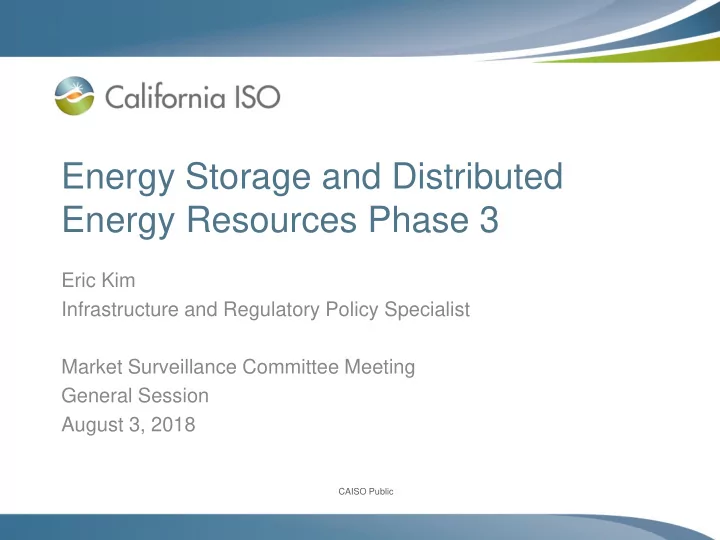

Energy Storage and Distributed Energy Resources Phase 3 Eric Kim Infrastructure and Regulatory Policy Specialist Market Surveillance Committee Meeting General Session August 3, 2018 CAISO Public CAISO Public
Proposals Under ESDER 3 1. New bidding and real-time dispatch options for proxy demand resources (PDR) 2. Removal of the single load serving entity (LSE) aggregation requirement and the need for application of a default load adjustment (DLA) 3. Load shift product for behind the meter (BTM) storage 4. Measurement of behind the meter electric vehicle supply equipment (EVSE) load curtailment CAISO Public Page 2
New bidding and real-time dispatch options for PDR • Extending two bidding options similar to intertie resources to extend real-time market notification 1. Hourly Block – Energy schedule is committed for the full hour and is a “price taker” for RT prices with communication 52.5 minutes before flow of energy 2. 15 min Dispatchable – Dispatched in FMM with communication 22.5 minutes before flow of energy CAISO Public Page 3
Proposing to remove the single LSE aggregation requirement and application of the DLA • The CAISO proposes to – Remove the requirement of a PDR or RDRR resource aggregation to be limited to one LSE – Develop a SIBR rule to only accept bids at or above the Net Benefits Test price for these resources • Eliminates the need for the default load adjustment settlement mechanism tied to the resource’s LSE CAISO Public Page 4
Load Shift Product for Behind the Meter Storage The PDR-Load Shift Resource (PDR-LSR) will enable both the decrease and increase of load as a grid service. Key features – Requires direct metering of the BTM energy storage device – Resource pays full retail rate for all charging energy – For load curtailment • Maintains RA capacity eligibility (traditional DR service) • Non-exporting rule applies – For load consumption • Ineligible for RA capacity and ancillary services • Bid to consume must be at a negative price CAISO Public Page 5
Bidding and Energy Services Bidding • Both PDR-LSR bidding options must be uniform – 15-minute or 5-minute dispatchable • Will be eligible for bid cost recovery • PDR- 𝑀𝑇𝑆 𝑑𝑣𝑠𝑢 can bid from NBT price to Bid Cap • PDR- 𝑀𝑇𝑆 𝑑𝑝𝑜𝑡 can bid from Bid Floor to < $0 Energy Services • Energy • Flexible Ramping Product • Day-ahead FRP ( Future DAM enhancement ) CAISO Public Page 6
PDR-LSR Performance Evaluation Methodology • Will measure and net out “typical use” to define incremental value of load shift provided – LSR-curtailment • 𝑀𝑇𝑆 𝑑𝑣𝑠𝑢 = 𝐻 𝑢 − 𝐻 𝑀𝑁 – LSR-consumption • 𝑀𝑇𝑆 𝑑𝑝𝑜𝑡 = 𝐻 𝑢 − 𝐻 𝑀𝑁 LSR = Total curtailment/consumption provided 𝐻 𝑢 = Meter value of device 𝐻 𝑀𝑁 = Typical use value CAISO Public Page 7
PDR- LSR “typical use” calculations • Typical Use Curtailment ( 𝐻 𝑀𝑁𝑑𝑣𝑠𝑢 ) : 10-in-10 CLB, using 10 non-event intervals including both consumption and curtailment but only accept a value that is at or above 0. 𝐻 𝑀𝑁 = 𝑁𝑏𝑦 𝐻 𝑀𝑁𝑑𝑣𝑠𝑢 + 𝐻 𝑀𝑁𝑑𝑝𝑜𝑡 , 0 • Typical Use Consumption ( 𝐻 𝑀𝑁𝑑𝑝𝑜𝑡 ) : 10-in-10 CLB, using 10 non-event intervals including both consumption and curtailment but only accept a value that is at or below 0. 𝐻 𝑀𝑁 = 𝑁𝑗𝑜 𝐻 𝑀𝑁𝑑𝑣𝑠𝑢 + 𝐻 𝑀𝑁𝑑𝑝𝑜𝑡 , 0 CAISO Public Page 8
Key points from performance evaluation methodology of PDR-LSR • Both consumption and curtailment values are used when calculating “typical use” • The no net-export rule will only apply under curtailment • When finding non-event intervals for both curtailment and consumption, both consumption and curtailment events will be considered “events” and not used in the CBL CAISO Public Page 9
Example: Derivation of Typical Usage (current vs proposed) +130 Current- Typical Use Calculation: +125 Average all positive values over 10 periods +100 +75 Proposed- Typical Use Calculation: Average all positive and negative values over +30 10 periods +25 Current Proposed 0 -25 -50 -75 -100 -125 CAISO Public 10
Example 1: Typical Usage in same direction as ISO dispatch would be used to establish response +125 +100 ISO Dispatch = 100 kWh (discharge) +75 Typical usage calc. = 25 kWh ( e.g. retail load +50 mgmt.) +25 Typical Use 0 Expected metered movement of resource would be 100 kWh for ISO dispatch incremental to the + 25 kWh for typical service provided (e.g. retail load mgmt.), thus: Expected Metered Output = 125 kWh CAISO Public 11
Example 2: Typical Usage in opposite direction of ISO dispatch would be set to zero (0) to establish response +125 +100 ISO Dispatch = 100 kWh (curtail/discharge) +75 Typical usage calc. = -25 kWh ( e.g. +50 recharging device) +25 0 -25 ISO expected movement of the resource would be 100 kWh to meet the ISO dispatch (left illustration). ISO’s proposed Expected Metered Output = 100 kWh Storage stakeholder requests movement from typical use position be considered in to meet the dispatch (right illustration) Storage community’s proposed Metered Output = 75 kWh (adds typical use as part of performance) CAISO Public 12
Potential scenario: Example 2 CAISO Ramp Partial-peak Peak Demand Charge Demand Charge 11am 12pm 1pm 2pm 3pm 4pm 5pm 6pm 7pm 8pm 9pm CAISO Public Page 13
Proposing to enable EVSE sub-metering and extend MGO performance method for EVSEs • The proposal will allow for an EVSE’s performance to be measured differently from the host facility CAISO Public Page 14
Registration and Metering Standards • EVSEs will be able to calculate two types of customer load baselines 1. EVSE residential – Will use a 5-in-10 customer load baseline 2. EVSE non-residential – Will use a 10-in-10 customer load baseline CAISO Public Page 15
Recommend
More recommend